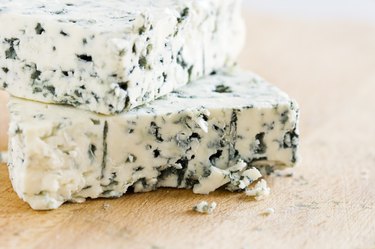
Blue cheese is a source of high-quality protein and provides flavor for salads, sandwiches and hot recipes, but just like pretty much any other food out there, too much can be unhealthy.
A moderate amount of blue cheese can fit into most healthy diets, so talk to a nutritionist if you need help developing a healthy meal plan with blue cheese. If you over-consume it, here are some of the negative side effects to expect.
Video of the Day
Video of the Day
Weight Gain
Blue cheese can lead to weight gain because it has a high calorie density, which means that it has a high number of calories in each serving. There are 99 calories in a single ounce of blue cheese, so eating more calories than you had intended is easy when you are eating blue cheese, because you may not feel full very quickly. Low-fat or fat-free cheeses may be better choices for controlling your weight.
High Cholesterol
Blue cheese may increase your cholesterol levels because it provides 5 grams saturated fat per serving. A heart-healthy diet limits saturated fat, such as from full-fat cheese, fatty meats, butter, palm oil and coconut oil, and healthy adults on a 2,000-calorie diet should not let more than 25 percent of their daily calories come from fat, and less than 7 percent of those should be from saturated fat, according to the Cleveland Clinic.
Another reason why blue cheese may raise your cholesterol levels is that each ounce contains 21 milligrams of dietary cholesterol, and healthy individuals should not have more than 300 milligrams per day.
High Blood Pressure
Each ounce of blue cheese provides 391 milligrams of sodium, and a side effect of blue cheese is that it can lead to higher blood pressure. A high-sodium diet makes it more difficult to control your blood pressure, and healthy adults should not have more than 2,300 milligrams of sodium per day.
All cheese is high in sodium, according to the Palo Alto Medical Foundation, and other dairy products, such as yogurt and milk, are better choices for your blood pressure because they are high in potassium and lower in sodium.
Inadequate Calcium
Choosing blue cheese can lead to inadequate intake of calcium because blue cheese has less calcium for the number of calories than other dairy products have.
An ounce of blue cheese has 99 calories and 150 milligrams of calcium, while a cup of yogurt or reduced-fat milk provides about 90 to 130 calories and 300 to 450 milligrams of calcium, according to the 2010 Dietary Guidelines from the U.S. Department of Health and Human Services. Calcium is an essential mineral for strong bones.